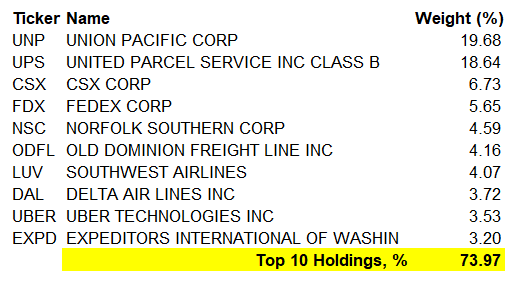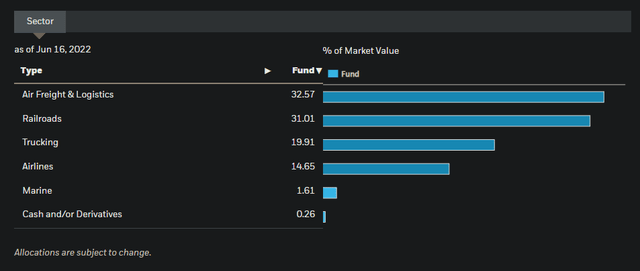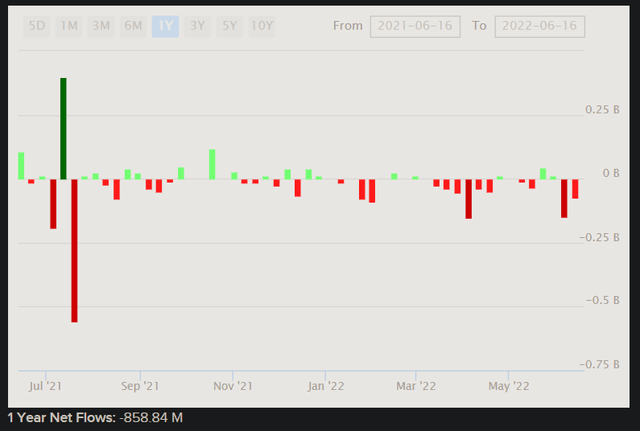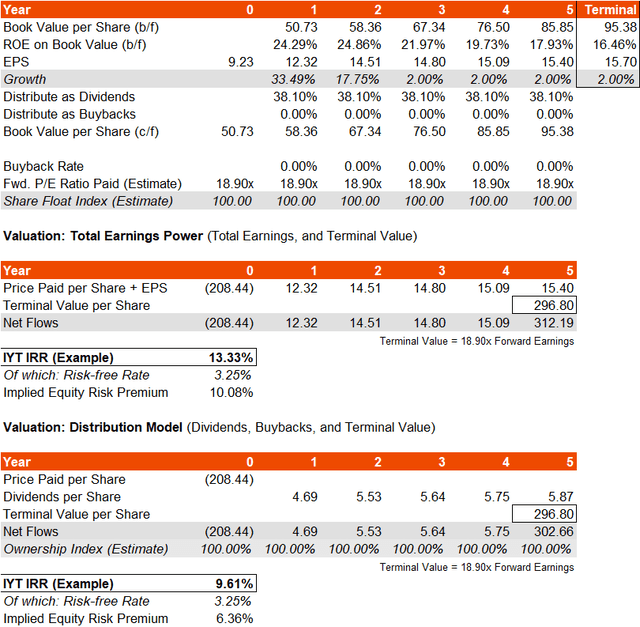Marcus Lindstrom/E+ via Getty Images
iShares US Transportation ETF (BATS:BATS:IYT) is an exchange-traded fund focused on the transportation sector. The fund invests in listed U.S. airline, railroad and trucking companies. IYT is designed to track the performance of its benchmark index, which is the S&P Transportation Select Industry FMC Capped Index. IYT had 52 holdings as of June 16, 2022, and a full sector breakdown is illustrated below. The expense ratio of the fund is 0.41%, and assets under management were $789 million as of June 16, 2022.
As you can see, the largest exposures are Air Freight & Logistics (33%) and Railroads (31%); also Trucking (20%), and Airlines (15%). The fund is fairly balanced across different segments of the transportation sector. However, IYT’s benchmark index does use a capping rule, and this becomes apparently important when you look to the portfolio itself; the largest two holdings together represent a full 38% of the fund.
Data from iShares.com
The top two holdings are Union Pacific Corp (UNP), a freight-hauling railroad that operates 8,300 locomotives over 32,200 miles routes in 23 U.S. states west of Chicago and New Orleans, and United Parcel Service (i.e., UPS) (UPS), an American multinational shipping & receiving and supply chain management company.
IYT has fallen roughly in line with the S&P 500 U.S. equity index this year, and so we don’t see any notable under- or over-performance. It is interesting to note separately though that IYT typically carries a beta of 1.18x, while net outflows over the past year exceed the present-day total AUM (see below). Over the past year, $859 million has left the fund, leaving AUM now at $789 million, as mentioned earlier.
So, assets under management have basically halved, while historical beta is actually almost 1.20x. With IYT roughly matching the S&P 500 index, you could argue it is holding up well. In the past, we might have expected the sector to be doing worse. While there have been plenty of supply chain issues caused by a ramp in consumer demand post pandemic, that same ramp in consumer demand (which has also contributed to inflationary pressures) has been a generally constructive backdrop for transportation companies (shipping goods). Now, as fears are growing of unsustainably easy monetary policy, persistent inflation, and near-term recession risks, IYT is perhaps starting to look a lot less attractive.
On the other hand, IYT has fallen substantially this year along with other stocks (iShares report YTD performance at the time of writing of -24.49%). So, it is worth gauging the value of IYT relative to price.
IYT’s benchmark’s most recent factsheet, as of May 31, 2022, reported trailing and forward price/earnings 25.23x and 18.90x, respectively, with a price/book ratio of 4.59x, and an indicative dividend yield of 1.51%. Using this information, I calculate an implied forward return on equity of 24.29%, and a distribution rate of earnings into dividends of 38.10%.
We can assume the forward return on equity is probably unsustainable (we should at least start by being conservative); I would also note that Morningstar‘s current three- to five-year average earnings growth rate is estimated at 14.46%. Given S&P Dow Jones Indices projecting forward one-year earnings growth at 33.49% (implied by the trailing and forward price/earnings ratios), to bring our three- to five-year projection in line with 14.46%, we would need a fairly steep drop in earnings growth. I will decide to guess 18% in year two, and then 2% thereafter (i.e., front-loaded growth, followed by stable growth roughly in line with inflation for the time being).
Keeping the dividend distribution rate the same at 38%, and assuming no buybacks, the return on equity drops to 16% in year six, and keeping the terminal forward price/earnings ratio constant with today’s, the implied IRR could be as high as 13% (or 9-10% if we focus on dividend distributions).
The forward price/earnings ratio in the terminal year is 18.90x in the above calculation, the same as today’s; the implication is a forward earnings yield of 5.29%. That seems low, but if you imagine an ERP between 4.20-5.90% (a fair equity risk premium is 4.20% to 5.00%, but you could adjust the upper bound for IYT’s beta of 1.18x), and also assume a risk-free rate of circa 3.25% (roughly where the current U.S. 10-year yield is), the implied difference is anywhere from 2.16% to 3.86% in long-term earnings growth (implied).
Since long-term nominal inflation is probably going to be closer to 2% in the long run (to perpetuity), unlikely much more, you can see here that IYT has some positive skewness and suspected inflation-adjusted growth potential over the longer run. Perhaps the market beta for the fund will settle in the long run too. The 18.90x multiple does not seem particularly rich. However, in year 6 (our terminal year), if we assumed that IYT’s portfolio was looking at long-term growth of only 2%, the multiple should in theory contract to something more like 16.7-17.5x. That would take our original IRR gauge from 9.61-13.33% to a lower potential of 7.10-11.00%; that is still decent, but it does suggest a tighter underlying equity risk premium on the lower end.
On balance, while I have been bearish on IYT after taking originally a neutral stance, after the recent downside I would now be back to neutral on the fund. The fund has fallen since my last article of circa -22.01% on a total return basis. Now, it appears to offer reasonably good value, but not enough to make the fund seem safely undervalued. Also, it is possible that earnings estimates are exaggerated; while my notional estimates might be seen as conservative in some spaces, we can also assume that equity risk premiums will expand for IYT should there be a recession or a series of negative earnings surprises within the portfolio (which is itself naturally concentrated).





Be the first to comment